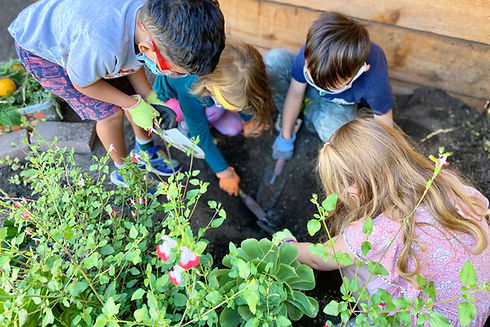Mandarin Immersion
中文沉浸式
Our Chinese curriculum has been designed by two AMI Montessori Chinese teachers along with a Chinese elementary school teacher. With over ten years' experience of observation and practice in the San Francisco Bay Area, the curriculum consolidates developing the children’s listening, speaking, reading and writing skills with purposeful guidance and interesting activities. Montessori is a significant part of the Chinese curriculum, and our Chinese program also contains Reggio Emilia project-based activities, and ‘Orff music’, which meet the children’s cognitive and language needs from a variety of diverse backgrounds.

Our unique Chinese curriculum
-
Based on local students’ learning style and needs
-
Applies the Reggio Emilia approach to inspire the children’s imaginations and language expression
-
Focuses on increasing children’s observation and critical thinking
-
Grace & Courtesy lessons combined with Chinese etiquette
-
Uses a parent user friendly record keeping and tracking system
-
Encompasses a variety of books and educational materials
-
Uses educational games, music, conversation & theme projects

Project Based Learning
Montessori Curriculum
Art
Music
Science
Gardening
Chinese Culture

How to learn Mandarin
Listening
Repeating
Speaking
Reading
Writing
听
说
阅读
重复
写
Expressing
Thinking
Applying
Writing
表达
思考
应用
.jpg)
Listening 听
The children immerse themselves in the Mandarin speaking environment daily. They continually learn Chinese without thinking, which Montessori says is an “absorbent mind”. When the prepared environment has Mandarin speaking teachers, the children with advanced Mandarin language knowledge, and purposefully designed materials, naturally help the other children who don’t yet know Mandarin. Eventually, the latter children will gradually understand daily conversations in Mandarin, and increase their vocabulary through continuous engaging activities, which improves the child’s listening as well. In terms of the children who already speak Mandarin, the teachers follow the child’s interests to design a curriculum, with customized activities which expand their knowledge, expression, and critical thinking.

Repeating 重 复
The foundation of learning a language is repetition. Children typically repeat sounds and pronunciations existing in their environment by imitating adults and their peers, which enables them to talk with simple words, converting phrases to sentences. The children learn through vision, touch, and hearing sounds, which enable them to understand an activity. The young children deepen their acknowledgement with repetition, which connects the objects to language. Children with strong Chinese speaking and listening skills naturally teach other children to better practice their language expression, including the usage of vocabulary and sentences. For example, “Please look, this is a Panda Bear” or “Please wash your hands before eating”.

Speaking 说
Each child wants to express their thoughts and feelings. Children with no prior Chinese background are able to communicate while they are in the process of absorbing and repeating in the Mandarin immersion environment. Children with higher level Mandarin skills are able to lead various small group activities.
.jpg)
Reading 阅 读
Reading progress begins by knowing the structures of characters, their connection to objects, and to ordinary life scenes. The child’s vocabulary increases as the children read a wide range of books in Mandarin. A series of story books and books of character will successively strengthen the child’s reading skills. Our unique “role-play/performance” reading method allows children to understand the characters and content of sentences through their body language, vocal variety, and emotional gestures. The child will soon be confidently reading stories in small groups.
.jpg)
The strength of the child’s writing hand increases through a series of practical repetition. The child starts from simple strokes, building up to simple characters and sentences. Writing is based on daily learning in subjects including geography, math, language, grace & courtesy.

Expression 表达
We value our children’s imagination and verbal expression. Once the children have immersed themselves in the prepared Mandarin environment for one to two years, they can express their feelings and thoughts through observation, drawing and other activities. During the group sharing time, they are better able to confidently ask and answer each other's questions, and by listening to the context, the group dynamic allows for integrating the information and organizing thoughts and words independently. This will greatly enhance their learning and they soon will be able to communicate in Mandarin fluently.
Writing 写

Children need time to absorb knowledge and feeling through five senses. Independent thinking allows children to solve problems, understand cause and effect, consequence for actions, and comprehend logical sequences of events.

Applying 应用
Language can be applied to a variety of events and situations. Through various activities and hands-on experience, the learned knowledge enables the children to communicate smoothly, bring up questions, and collaborate with others as a team to complete different multi-faceted projects.
Thinking 思考
Show - and - Tell
Chinese Culture
We pass the Chinese culture to the young generations.



Concentration Care Respect



Architecture Food Tea



Art Chinese Medicine Traditions
Simplified Chinese
简 体 中 文
Standard Chinese
普 通 话
-
Our Chinese teachers speak standard Mandarin to the students.
-
We focus on learning through inquiry and promoting children's sense of agency




